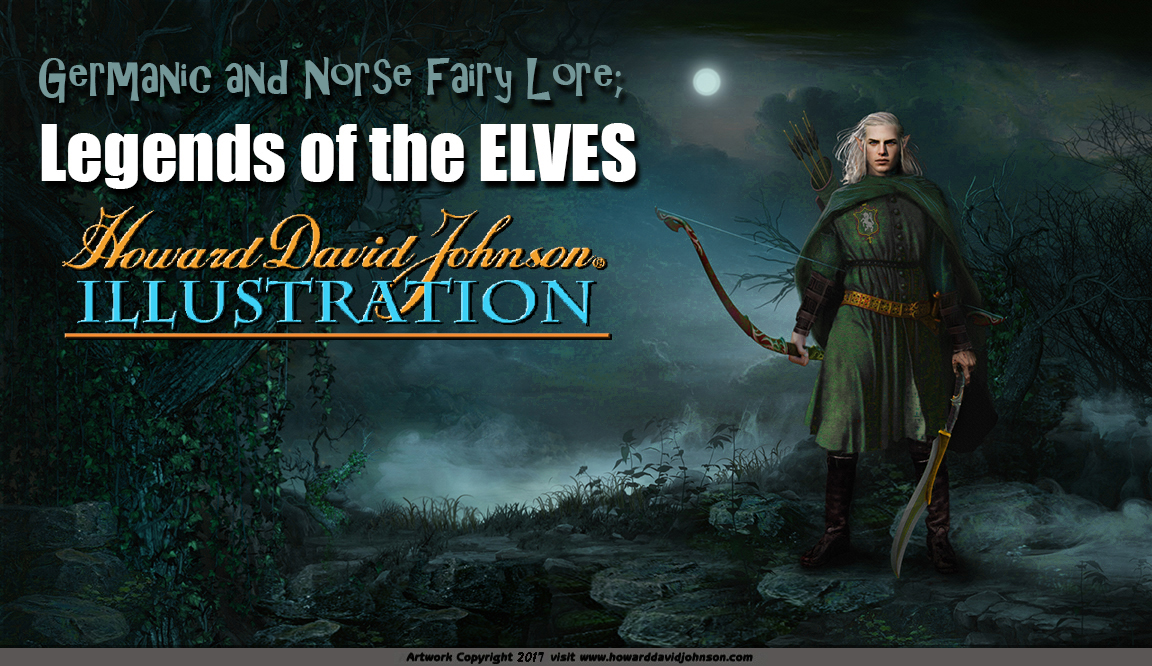
The Elf Paintings Art Gallery... Illustrations of Elven legends and Mythology: Featuring paintings and pictures of Teutonic and Scandinavian Sagas ~Ancient Nordic Folktales of the Vikings by Contemporary American Illustrator Howard David Johnson, whose illustrations of Mythology have been published all over the world by distinguished learning institutions and publishers including the Universities of Oxford and Cambridge.
|
|
|
|
The Ljósálfar or Light Elves
In German Folklore, Elves, (álfar) were much like angels and like their cousins the Eladrin (High elves) are fair and beautiful, handsome, and have pointed ears and no body hair except eyebrows, eyelashes and hair. Elves mature at roughly the same rate as humans, though they are not usually considered past adolescence until they reach 110 years of age.
Tales from Alfheim ~ The Legends of the Elves live on...

A Tale of the Ljósálfar of The Hidden Kingdom of Riverhelm in the realm of the Álfheim...



The Queen Mother Irithiel, the beautiful enchantress. (above left) When her husband the Emperor Azriel, the Angel of Death died, Irithiel refused to re-marry and the kingdom was entrusted to The Three Lords of the Elves to rule as regents until he had an heir. With seven marriageable daughters this seemed an easy task... but the regents coveted the throne and set to war on one another...
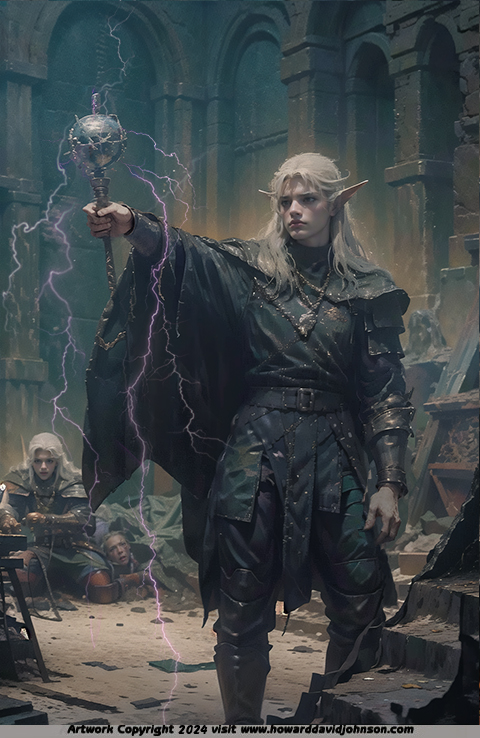


The 1st Regent ~ Eroan Spellbinder" an Elven Dark Mage and Dragon Meister (above left) The 1st Daughter Eiriell, Duchess of Riverhelm (above center) has the ability to create powerful illusions. She has embraced her duties as crown princess but dispises the brutal warlord regent she must wed.. Eladriel Stormhammer, Duke of Ńordariel and 2nd Regent of Riverhelm.
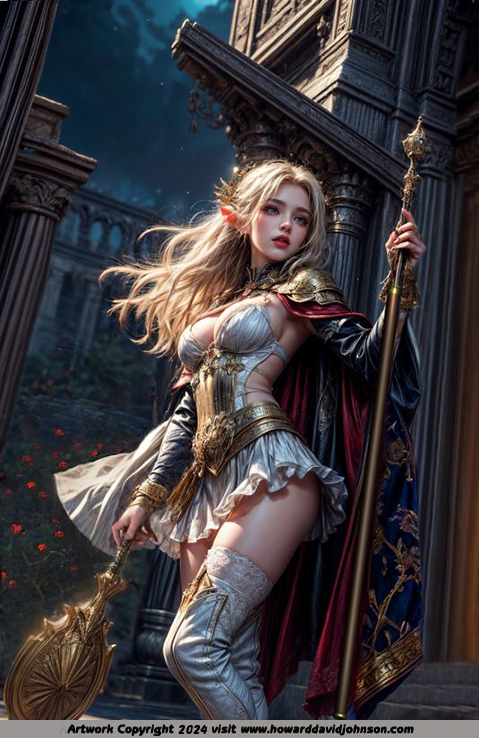


2nd Daughter Alathriel Farspell, An Enchantress with all her mother's gifts to create, teleport, reverse spells, generate magic fields, levitate, restore, heal, transform and sometimes foretell the future, 3rd Daughter (above center) Sylanna Shadowtalon, Displeased with her arranged marriage, ran away and joined the Forest Rangers... 4th Daughter Eloria Dawnwhisper, Has chosen the life of an adventurer and joined a party, specializing in elemental magic, and master of wind and water... can use magic to draw upon the physical forces of the natural world.
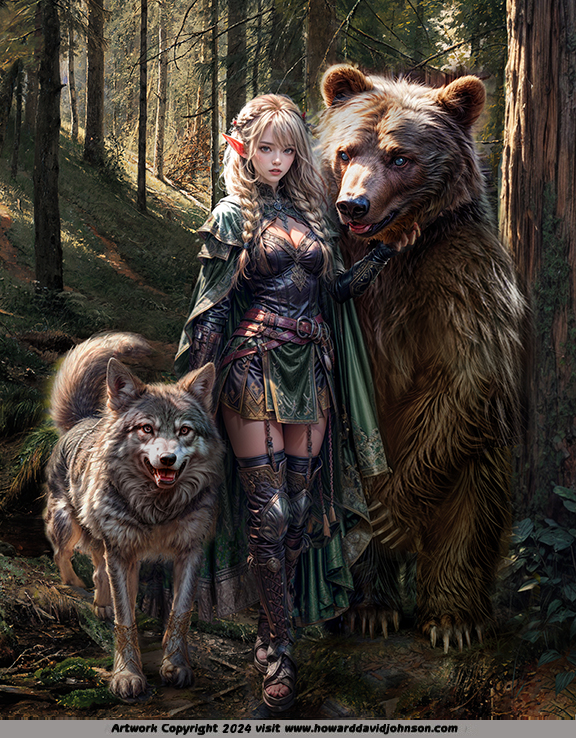


The 5th Daughter Eiraira Spellbinder, A Beast Tamer with instant influence over all manner of beasts, birds, serpents and creeping things,
The 6th Daughter Ariella Stardust The shy one, a healer and an expert in herbs and poisons...
and 7th Daughter Nimwin Riverwind
Is unsure as yet of her gifts and is haunted by reflections of the way life used to be...
Elves from J.R.R. Tolkien's LORD of the RINGS
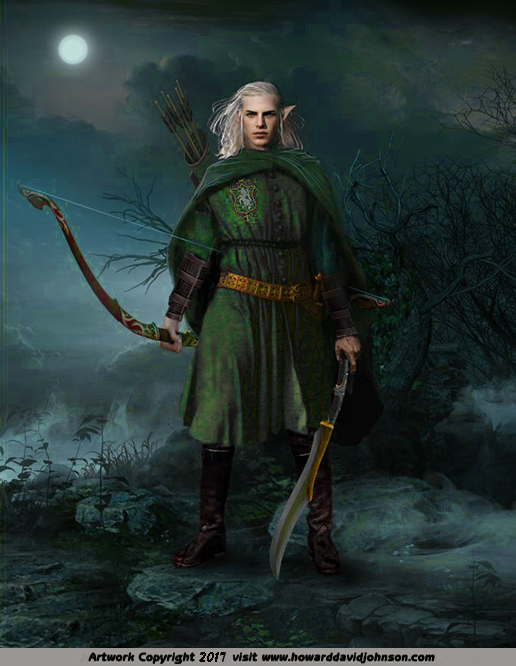


"Legolas Greenleaf", "Elven King Thranduil of the Woodland Realm" and "Galadriel of Lothlórien"
Forest Ranger Sylanna Shadowtalon of the Ljósálfar
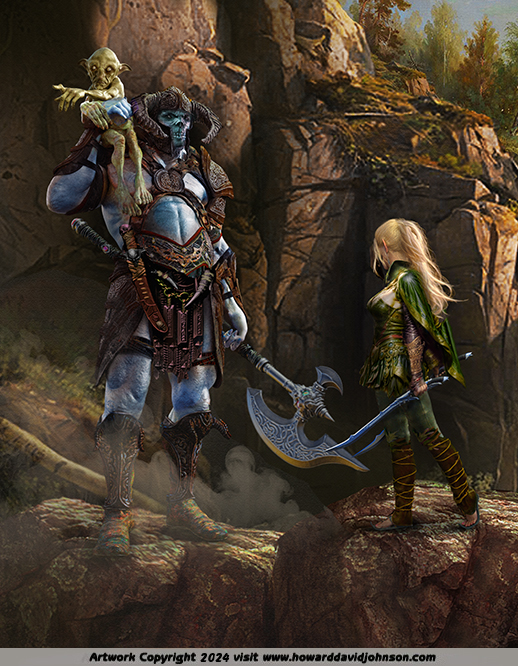


"The Goblin Oracle", "Sylanna Shadowtalon of the Ljósálfar" and "Sylanna and the Old Forest Goblins"



" The Troll Hunter" ,"Elf Ranger Sylanna Shadowtalon" , and "At Niflheim's Gate"

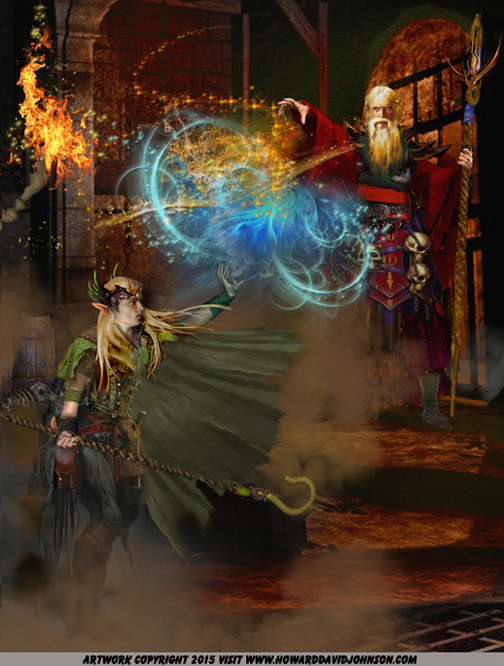

"A Slayer of the Dark Elves" [Dökkálfar], "Mystic Vengeance of the Gand Alf" [wand elf] and "An Elf Maiden of the Ljósálfar"
The King of Elfland's Daughter by Lord Dunsany
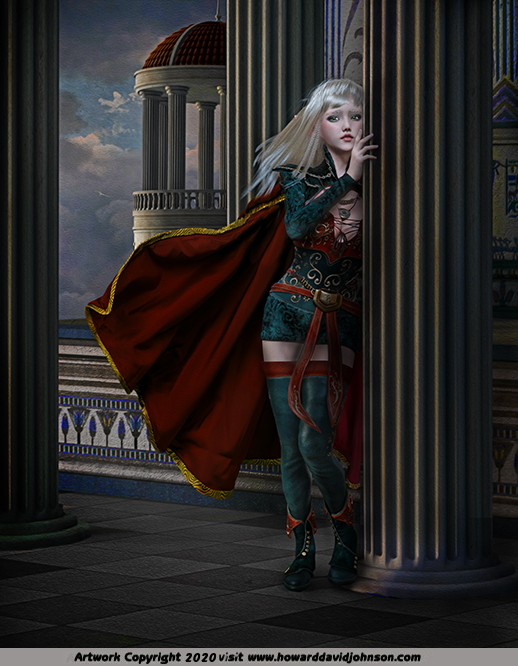


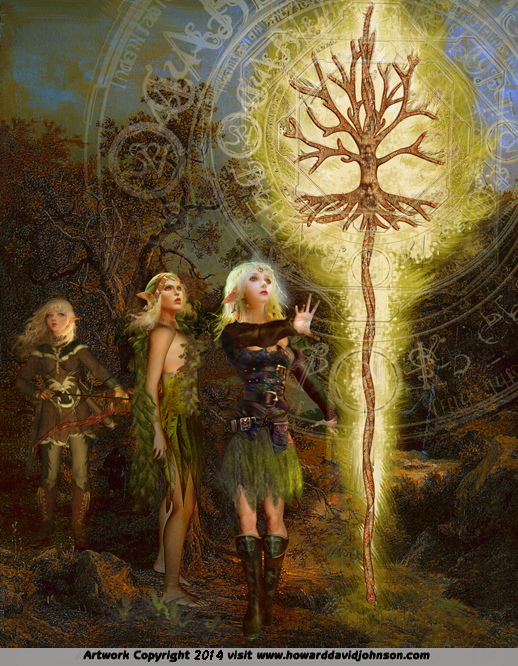

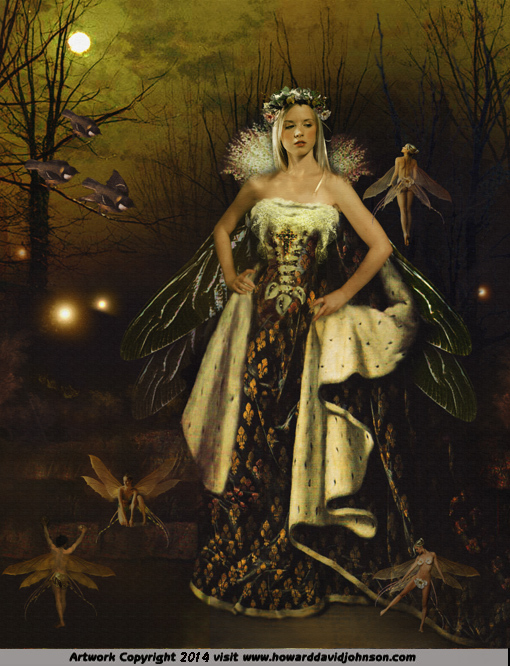
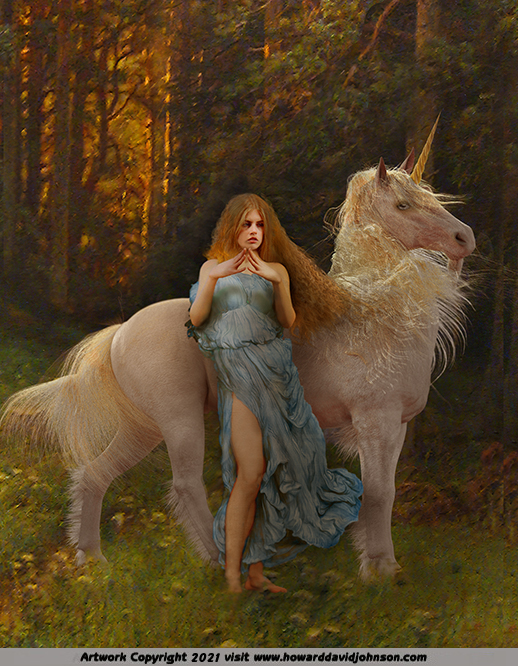


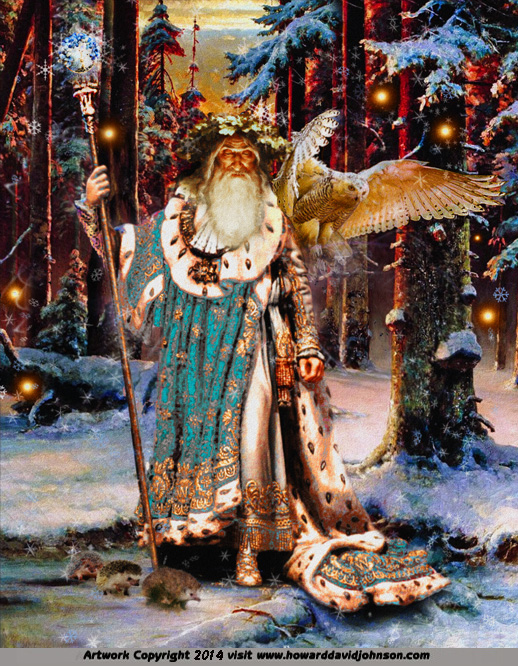




Thank you for visiting the Elf Art Gallery of Howard David Johnson...
Music by Peter Ilyich Tchaikovsky ( 1840- 1893) - "Swan Lake"
Enter a world
of Beauty and Imagination... INDEX of GALLERIES ~ LINKS to LARGER ART The
Realistic and Fantastic Art Galleries of Contemporary American
Illustrator Howard David Johnson Click on
these Fun Educational
Realistic Art Gallery link icons for Two-fisted Tales of VALOR
&
Frontline Combat featuring Legendary Warriors of History, Knights and
ladies of
Arthurian Legend, Celtic, Nordic, Asian and Olympian gods &
monsters,
unicorns, dragons, fairies... and more! All these pieces of art and the text are legally
copyrighted and were registered with the U.S. Library of Congress
Office of Copyright by the author, Howard David Johnson All rights
reserved worldwide. Permission for many academic or non-commercial
uses is freely and legally available by simply contacting the author
via e-mail or visiting www.howarddavidjohnson.com/permission.htm STYLE and
TECHNIQUE "Those
who are enamored of practice without science are like a pilot who goes
into a ship without rudder or compass and never has any certainty where
he is going. Practice should always be based upon a sound knowledge of
theory, of which perspective is the guide and gateway, and without it
nothing can be done well in any kind of painting."
Since
boyhood he has passionately copied the old masters. To create his fairy
paintings, he usually starts with a thematic concept followed by
a rough realistic pencil sketch, then followed by his original
photography, often traveling to find suitable scenes and locations and
then working in his Photography studio with live models from his
sketches. He then assembles a variety of elements which are realistic
and original. As a boy he dedicated his life to art in 1960. From
1965- 1999 he used xeroxes and tracings to make his preliminary
collages. This is patterned after the manner used by Maxfield
Parrish and other 19th century notables. Beginning with a tracing, he
then draws or paints from these new complex original Computer Photo
Montages. Many of these are on display on this web and slated for
future completion in a variety of traditional art media. As this
happens, the finished painting is substituted in the exhibit. For
decades David has sought out the most beautiful models and brought them
in for sessions in his analog photography studio. Using a strategy
employed by J. W. Waterhouse, (the old master David imitates most )-
his wistful and graceful models cannot be underestimated in their
contribution to the stunning beauty and the potential for lasting
appeal of his work.
His favorite medium for Fairy Paintings is colored pencil because of
the high speed and low expense, and people began expressing difficulty
in telling his 'Prismacolor paintings' from photographs in the early
1980's. In the last 35 plus years he has also mastered Oils,
Pastels, Acrylics, Watercolors, Inks, Scratchboard, Gouache,
Photography, and the highly controversial digital media. As a
commercial illustrator David has not only used the computer to create
art but has been involved in the development of computer imaging
software for Adobe Photoshop. Working in a realistic style inspired by
classic illustrators David is deeply rooted and grounded in the
Greco-Roman artistic tradition, Feeling that with realistic art, the
human form is the ultimate arena for artistic expression. His lifelong
dream came true when his Traditional Realistic Art was exhibited in the
British Museum in London England in 1996. His mixed media has also been
displayed in numerous other ones since such as the Metropolitan
Museum of Art. Having achieved international acclaim as a traditional
visual artist he discovered digital media ( Art Numérique ) in
1999. Because of his passion for realistic art and photography he
elected to embrace it and joyfully be a part of this historic era in
the visual arts as a 21st century realistic visual artist. Only
David's finest fairy paintings are ever rendered in oils
Since 1972 when he began his career as a scientific illustrator for the
University of Texas he has earned his living illustrating all kinds of
books, magazines, CD covers, and all sorts of games, greeting cards,
calendars, portraits, murals and the like with his contemporary
realistic art... HDJ's Realistic Art has appeared in every major
bookstore chain and fantasy gaming shop in The United States and has
been used in educational texts and magazines all over the world. This
site features realistic paintings & pictures for the twenty-first
Century including some oil paintings, as well as lots of
other exciting media such as colored pencil drawings, pastel paintings,
acrylic paintings, gouache paintings, watercolor paintings, and pencil
drawings, and also featuring studio, field, & aerial
photography, digital painting and photo-montage and all these
media mixed in an assortment of experimental combinations. In addition to his mastery of traditional
media, Howard David Johnson now combines drawing, painting,
photography, and digital media with more than thirty years of
experience in these fields to create his 21st century fairy paintings
and pictures. Did you know the Greek word "Photography" means "Painting
with Light"? Today with the advent of computers it truly lives up to
it's name. Due to developments in Art and Technology, a broader
definition of painting is needed than that which is found in common
usage. Announcing Art Numérica -an exciting merger of traditional
visual art and cutting edge technology... a new art form for the
twenty- first century... Digital Art media is not limited to realistic
or fairy art but also offers limitless horizons for everything from
cartoons to abstractions. It is the most dramatic development in the
visual arts since the Renaissance. Working in a wide variety of
media to create his fairy art he offers his customers a host of payment
and product options. He delivers the rights to these custom made
copyright free illustrations and old fashioned customer service when he
does work-for-hire. He loves to paint custom oil paintings and accepts
commissions with down payments starting at one thousand dollars. Other
media, like colored pencil or digital are less expensive. On existing
works licenses start at only $100. ***** 2006
Artist's
Statement:
"Did you know that many of the breathtaking works Pre-Raphaelites were
doing in oils in the 1800’s were declared not to be Art? In London the
Royal Academy had a very narrow view as to what qualified. No wonder
Rossetti led a revolt
against them. How about Styles? Impressionism is a great example; It
was not
enough that these institutions rejected the work, but they felt the
need to
destroy the person’s reputation and livelihood. Of course collectors
pay
millions for these Impressionistic paintings now, and Curators,
Historians and
Professional Art Critics all hail them as sensitive works of fine art.
When
Monet submitted his work to the Salon in Paris, they said" A monkey has
gotten a hold of a set of paints" and would paint huge "R"s for
"rejected on the back canvas. Rejecting him was not enough for them.
They
wanted to be sure he never sold another picture. They wanted to hurt
him and his
family for sick sadistic pleasure. He got really good at re-stretching
his
canvas with a double layer to cover up their hateful defacement of his
original
art. They saw themselves as powerful as the deadly committee for public
safety
in the French Revolution as far as the Art World went and delighted in
"sending artists to the guillotine", so to speak. These hateful little
petty tyrants were unable to keep his name out of the history books or
to keep
his paintings for selling for millions of dollars. This is the
treatment someone
who creates a new style gets, but developments in applied technology
like
manufactured tube paints as opposed to hand mixed paints were violently
rejected
by these types as well and they forcefully proclaimed anyone who used
paints
from a tube was not a "real artist". Well, tube paints are pretty well
accepted now. So will photography and digital media in time. You
probably
know how bad Photographers were treated, but
now it is a respected Art
Form. I Remember the hateful things they said about Pastels and Mary
Cassat, and
now Pastel Paintings are considered Fine Art and Mary Cassat’s works
are
regarded as masterpieces. Now that snobs have Digital Artists to look
down on,
Colored Pencils are starting to get some respect. Our day will come."
~ Howard David Johnson All these fairy
paintings &
text are legally copyrighted & were registered with the U.S.
Library of Congress
Office of Copyright in 2014 by the author, Howard David Johnson All
rights reserved
worldwide. Permission for many legal non-commercial uses is freely
available by simply
contacting the author or visiting
www.howarddavidjohnson.com/permission.htm ***** If your browser ever stops loading fairy Art click
refresh
Essay
Six: Copyright
Law and the Visual Arts in the Computer Age An
introduction to the Millennial Copyright Act for Artists A
brief, easy to understand essay in layman's terms on
21st century legal boundaries, guidelines, and western art traditions
by the artist
"All art is
ultimately some form of imitation, even if you are an expressionist
painter imitating an
abstract vision in your own mind. These new visual art creations of
mine take their
inspiration in part from the realistic paintings of the old masters
just as The Lord of
the Rings comes from The Ring of the Nibelung and European folklore and
West Side Story
came from Romeo and Juliet, which was in turn inspired by Antony and
Cleopatra. Much as
Rubens copied Titian, I copy Waterhouse and so on. Over the last 300
years,
ideas about female beauty have drastically changed and this has caused
many of the most
wonderful paintings of the old masters to seem 'ugly' to youthful
modern audiences. For
example, in the days of Peter Paul Rubens, being forty to sixty pounds
over-weight was
considered not only attractive, but was a status symbol. Beauty is in
the eye of the
beholder and tastes have clearly changed. I feel many classic themes
need to be redone to preserve interest and appeal for future
generations. This has
happened many times before as artists like Aesop, The Brothers Grimm
and Walt Disney have
appropriated, modified, and re-defined elements of our culture to
preserve it for future
generations. The legality of such use today depends on whether or not
the source is
protected by copyright law. You can draw or paint Shakespeare's fairies
for example and
publish them without permission but not more modern intellectual
properties like
characters from Star Wars or Mickey Mouse who holds the oldest
copyright dating from 1928. Our
shared cultural heritage, great works of art, literature, music and
drama, cinema, folk
tales and fairy tales are all drawn upon again and again by the
creators of new works.
These works in the public domain are both a catalyst and a wellspring
for creativity and
innovation. Even though all my Realistic Paintings are legally new
works and
protected under copyright law their inspiration comes in part from
works in the
public domain. The
public domain is a space where intellectual property protection (
copyright ) does not
apply. When copyrights and patents expire, innovations and creative
works fall into the
public domain. They may then be used by anyone without permission and
without the payment
of a licensing fee. My
sources have been transformed so much in the creation of these new
works of art that they
would not violate an existing copyright even if they were so protected.
Publicly owned national parks are also considered by many
to be public domain lands. Because of the recent extensions of the
terms of both
copyrights and patents, and the privatization of lands and other
resources owned by the
Federal Government, little is now entering the public domain. Look for
new litigation and
another time extension when Disney Corporation's Mickey Mouse copyright
is due to expire
in 2023. Where would Walt Disney be without the Fairy Tales of the
Brothers Grimm, Hans Christian Anderson,
or Victor Hugo? Where would Aaron Copeland have been without American
folk music? Thomas
Nast's Santa Claus without traditional images of Father Christmas?
Picasso without African
art? These are artists who made names
for themselves and even fortunes through Public
Domain appropriation, one and all. Some people are
actually outraged that there are some intellectual properties that
corporations do not
own. They feel appropriation is only appropriate if a corporation does
it. Corporations
created by public domain appropriation, now are the most powerful force
on Earth trying to
put a stop to new things entering the public domain forever through
lawsuits. The public
domain is a space where intellectual property protection ( copyright )
does not apply. It
was set up by our founding fathers, who felt creativity needed to be
rewarded on a
personal level for a time, and when copyrights and patents expired,
innovations and
creative works moved into the public domain.
Since the public domain is a treasure trove of information and
resources to be used by
future generations, many advocates are concerned that its stagnation
will make it more and
more difficult for future generations to find creative inspiration.
This
is least likely to hurt the motion picture companies who produce new
works
"in house" granting themselves permission, but the music industry which
brings in artists and new songs from the outside is being hit very hard
already. If a new song release resembles an old one, now there is
litigation. Visual Art Tradition
and etiquette suggest the most influential pieced borrowed
from the public domain should be mentioned at exhibits; these original
new
pieces Shown in my exhibits take their inspiration in part from the
paintings of
Waterhouse, Alma-Tadema, Moreau, Bouguereau, Leighton, Ingres, Moore,
Parrish, Rackham and
others. They showcase some of my favorite models. As a student of
fine art, copying
is a great way to learn and create fine art, but as a professional
illustrator things are
very different. Works done by artists out of personal motivation belong
to the artist who
created them, and they can sell licenses for divers forms of
publication. The law is clear
and simple regarding illustrations done for gainful employment. They
are called
"work-for-hire" under the law, and the rights to such works envisioned
by the
customer and specifically commissioned and paid for belong exclusively
to the customer and
the artist must specifically ask permission to ever legally use their
own work themselves.
Most people in this industry will be glad to give that limited
permission if asked. My art is
divided into two distinct groups; personal work partially copying the
old masters and
professional illustration applying these lessons to create totally
original works. I start
more often with a specific written request. This is the exact OPPOSITE
approach to
creating a picture from copying something that's there. Research
comes first. In the case of my illustration of the Spartan Warriors,
there were no
accurate sources in the public domain to copy correct Greek armor and
weapons in combat
poses from. Mostly I found images of effeminate men, wearing
nothing but a robe over
the shoulder and the wrong helmets. Finding history books at the
library with the accurate
helmets, shield designs, weapons, and armor was essential to get an
accurate depiction of
a Greek Hoplite. All the library had were stiff museum poses of
anything, but I hit
the research jackpot with some very simplistic flat line drawings of
great authentic Greek
shield designs. All the
elements must be found, gathered and assembled to create the dramatic
action scene the
client wanted. Next comes the layout. This is where the mathematics and
geometric design
come into the creative process. My wife, Virginia took a picture of me
nearly twenty years
ago on a carpentry project with the heroic Jack Kirby like pose I was
looking for mixed
with the texture and feel of a Frank Frazetta or Norman Rockwell
painting. Naturally, in
these cases I go to great lengths to make sure that my work looks
nothing whatsoever like
it's various inspirations and sources except in flavor and spirit. Of
course, the
characteristic old master's painting feel to the background most of my
illustrations have
was requested, and the picture was to have the flavor of a Howard Pyle
painting.
With regards to use of mechanical aids to create art: Did you know the
old masters traced?
To create his immortal "Mona Lisa" Leonardo Da Vinci used "Camera
Obscura" which is two mirrors set at 45 degree angles around the
corner with
parchment over it to trace onto. Michaelangelo used a similar technique
for the Sistine
Chapel. Think that makes it too quick and easy? You'll find once you've
finally got that
outline done right you're a long, long, way from being finished in any
medium... if these
men who set the standard for realistic excellence used them, why
shouldn't those who come
after them be permitted? Simple, because this is one of the most
carefully guarded
"secrets of the old masters" and most people don't know very much about
art
history... For more on Camera Obscura and the history of
photography and the use of mechanical aids to create art read essay
seven. When asked
why I usually work from photos I like to re-tell Norman Rockwell's
story about having to
paint a chicken: He set it up on a stump in a barn and goes to
painting. The chicken moves
it's head. He moves it back. The chicken jumps down. He puts it back.
He goes to paint.
now the chicken decides to make a break for it... he chases it down
clucking and screaming
and puts it back. Now it knows he's going to have it for dinner and it
goes completely
berserk. The next day, he came in and set the chicken back, snapped
it's picture, and the
photo held nice and still."
I have built up an enormous library of original 35 mm source photos for
use in my
realistic art. For decades I have been seeking out the most
beautiful models and
sometimes even their boyfriends and relatives, bringing them in for
sessions into my photography studio. The
law with regards to copy rights on photographs is simple - if you own
the negative you own the
rights. This new instant copyright without filing law is very nice for
photographers and artists working with their own photos, but not so
good for
free-hand drawings from the imagination and other non-photographic
based forms
of drawing and painting like cartoons. This is the main reason I use my
own photographs.
Using a strategy employed by J. W. Waterhouse, my wistful and graceful
fairy models cannot
be underestimated in their contribution to the stunning beauty and the
potential for
lasting appeal of my work. I am always make sure to both overpay them
for their time and
also the rights. I always get a written contract with the exception of
my dearest friends
and closest family who are always making cameo appearances. The models
get amenities and
services including portraits, portfolio photo sessions, photographic
reprints and
enlargements, leather presentation cases, webmaster services, original
art, and reprints
of their appearances in my drawings and paintings as well as above
scale cash payments at
the time of the shoot.
With regards to using
copyrighted material as a reference- When you have to paint a
wombat you can't fake
it- you need a picture! The law understands this and automatically
grants provision -
within reasonable limits; when using copyrighted sources the source
image
must be so transformed in overall appearance in the translation as not
to be
what the law calls "confusingly similar"...
If it's newer than 1928 you can bet it's probably copyrighted - they
had to renew exactly
26 years later in those days or it would pass into the public domain,
so it might not be
copyrighted if it wasn't a big moneymaker. Always be sure to check in
these cases. If it's
newer than 1999 under the millennial copyright act the law says it is
automatically
copyrighted without even filing. However, this new law is very tricky
in it's wording
because you must have already have filed with the copyright office in
advance if you ever
need to take legal action. They say it is copyrighted, but you
cannot sue
if it is not registered with the United States Library of Congress
Office of
Copyright. Because of this "instant copyright without
filing" clause, there is a serious danger of artists being made legally
helpless and left open to being cheated out of their work. From
an artist's standpoint, this is a huge improvement over the original 14
year
copyright term. When properly interpreted and acted upon, by filing
works with
the United States Library of Congress Office of Copyright, these laws
are GREAT for contemporary artists
and their estates, who will hold rights for seventy years after the
artist's death." ~ Howard
David Johnson M M I V ***** The Constitutional Provision Respecting
Copyright The
Congress shall have power... To promote
the progress of Science and the useful arts, by securing for limited
times
to Authors and Inventors the exclusive right to their respective
Writings and Discoveries. United
States Constitution Article I Section 8 ( This
essay is not meant to take the place of
expert legal council, but to introduce people to the basic concepts. ) If you
liked this Fairy Art
Gallery be
sure and visit Fairy Paintings II
and III above for
more costumed faery
pictures - featuring innocent faerie paintings and fairy pictures
suitable for all ages -
Thank you for visiting the faerie art
gallery
for fairy art faery art fairy
pictures digital
fairies faerie photos new fairies fairy paintings real faeries
fairy tale picture
gallery fairy illustrations faery pictures faerie paintings
contemporary faery art and
faerie photo art gallery faerie photo
art
new faerie art close-up faery art fairy pictures digital fairies
fairy paintings faerie photos exotic fairies new faeries the
fairy tale picture
gallery of Howard David Johnson... info@howarddavidjohnson.com Thank you for Visiting... Your business, letters, & links
are always welcome. ***** Art tradition and etiquette suggest the artists who have
been most influential should be mentioned at exhibits; these original
new pieces shown in this exhibit take their inspiration in part from
the paintings of Waterhouse, Alma-Tadema, Church, Godward, Moreau,
Bouguereau, Leighton, Ingres, Moore, Parrish, Rackham and others. Most
of my sources are changed so much they are impossible to detect, but
sometimes I make it obvious to pay homage. Where
would Walt Disney be without the Brothers Grimm, Hans Christian
Anderson, Victor Hugo and so many others? Where would Aaron Copeland
have been without American folk music? Thomas Nast's Santa Claus
without traditional images of Father Christmas? Picasso without African
art? These are artists who made names and fortunes through
Public Domain appropriation, one and all. Beethoven did
"variations on a theme" with the works of Mozart for the same reasons I
have done mine with Waterhouse and others- to learn and give homage to
the artists who most inspired me. Commercial Licenses are available for these Thank
you for visiting

Howard David Johnson is a contemporary artist
and photographer with a background in
the natural sciences and history. He works in
a wide variety of media ranging from traditional
oils, pastels and others to cutting
edge digital media. He loves mixing media. This site features
examples of his Paintings, including
illustration, photography, experimentalism, & fine art.
The various galleries linked to by the icons above show many
examples of his Fantastical Realistic Art, & are grouped by theme
rather than media. There are also several special pages with discussion
of media & Art galleries devoted to History, Classical Mythology,
Women of Mythology, & Celtic & Asian Myth & Legend.

